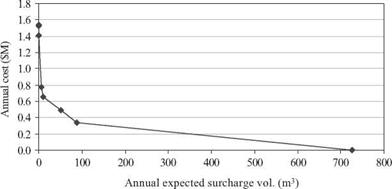Risk-based design without flood damage information
Conventional risk-based design and analysis ofhydrosystems requires information with regard to various flood-related damages. Such information requires an extensive survey of the type and value of various properties, economic and
social activities, and other demographic-related information in the regions that are affected by floods. For areas where flood-related damage data are unavailable, conventional risk-based analysis cannot be implemented, realizing that in any design or analysis of a hydrosystem one normally has to conduct hydraulic simulation to delineate the flood-affected zone and other related flow characteristics, such as water depth and flow velocity. The hydraulic characteristics, combined with property survey data, would allow estimation of flood damage for a specified flood event under consideration. In the situation where flood-related damage data are unavailable, the risk-based analysis of relative economic merit of different flood defense systems still can be made by replacing the flood-related damage functions with relevant physical performance characteristics of the hydrosystems that are either required inputs for hydraulic modeling or can be extracted easily from model outputs. For example, useful physical performance characteristics in urban drainage system design and analysis could be pipe length (or street area) subject to surcharge, volume of surcharged water, and maximum (or average) depth and velocity of overland flow. Although these performance characteristics may not completely reflect what the flood damages are, they nevertheless provide a good indication about the potential seriousness of the flooding situation.
For a given design, the corresponding annual installation cost can be estimated. Also, the system responses under the different hydrologic loadings can be obtained by a proper hydraulic simulation model. Based on the annual project installation cost of the system and the expected hydraulic response of the system, a tradeoff analysis can be performed by examining the marginal improvement in hydraulic responses owing to a one-unit increase in capital investment. Referring to Fig. 8.12 for a study to upgrade the level of protection for an urban drainage system in Hong Kong (Tung and So, 2003), it is observed that the annual expected surcharge volume decreases as the annual capital cost of the system increases owing to increasing level of protection.
|
Figure 8.12 Annual project cost versus annual expected surcharge volume. (After Tung and So, 2003.) |
The marginal cost MC corresponding to one reduction in surcharge volume can be written as MC = -9C/дSv, with C being the capital cost and Sv being the surcharge volume. As can be seen, the value of MC starts very low for the existing system and increases to an annual capital cost around HK$0.6M (which corresponding to a 10-year protection), beyond which the rate of increase in capital investment per unit reduction in surcharge volume becomes very high. From the trend of marginal cost, a decision maker would be able to choose a sensible level of protection for project implementation.







Leave a reply